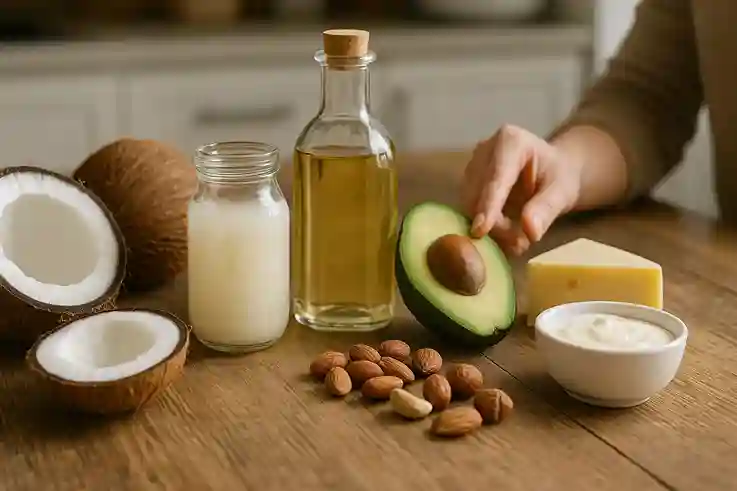MCT Foods are gaining attention for their unique ability to fuel both body and mind. These foods contain medium-chain triglycerides, a type of fat that digests faster than long-chain fats. Because of this quick breakdown, the body can turn MCTs into usable energy almost instantly.
People use MCT Foods for several reasons. Athletes rely on them for quick bursts of clean fuel. Students and professionals turn to them for sharper focus during long hours of work or study. Those on low-carb or keto diets also favor them because MCTs can help produce ketones, which support brain function.
The focus of this blog is simple. We will explore how MCT Foods provide steady energy, promote mental clarity, and support performance throughout the day. In doing so, you’ll learn why adding even small amounts of these foods can make a big difference.
What Are MCT Foods?

MCT Foods are sources of medium-chain triglycerides, a special type of dietary fat. Unlike long-chain fats found in most oils and meats, MCTs have shorter carbon chains. This structural difference makes them easier for the body to digest and absorb.
With long-chain fats, digestion is slower and involves bile salts and enzymes. In contrast, MCTs bypass many steps. They move directly from the gut to the liver. Once in the liver, MCTs convert quickly into energy or ketones.
This rapid process gives MCT Foods a unique advantage. They provide a fast fuel source without the sluggish feeling that often comes from heavy, fatty meals. As a result, people often use them to support active lifestyles, mental focus, and low-carb nutrition.
Key Benefits of MCT Foods
MCT Foods provide more than quick fuel—they support the body and brain in simple, powerful ways. Because they digest faster than regular fats, they deliver clean energy without heaviness. From sharper focus to steady metabolism, the benefits of MCT Foods fit easily into daily life.
Quick Energy Boost – Easy digestion, rapid fuel
MCT Foods digest faster than most fats. They skip several complex steps in the digestive process. Instead, they travel straight to the liver. There, they convert quickly into usable energy or ketones. As a result, the body can access this fuel almost instantly. This rapid process supports both physical activity and mental tasks.
For example, many people blend MCT oil into morning coffee. The body absorbs it quickly, giving a steady energy lift without the crash. This simple habit shows how fast MCT Foods can fuel both focus and performance.

Better Focus and Clarity – For brain health and ketones
MCT Foods often produce ketones, which the brain uses as clean fuel. These ketones support sharper thinking and longer attention spans. Therefore, many students and professionals use MCTs for improved mental clarity.
For instance, adding coconut oil or MCT oil to a smoothie can provide steady fuel for study or work sessions. This quick source of ketones helps maintain focus without the jitters that sometimes come with excess caffeine.
Support for Metabolism – Fat-burning potential
MCT Foods may slightly increase calorie burning. They provide fuel without storing as much as body fat. As a result, they can support metabolism in a subtle but useful way. When combined with exercise and balanced eating, they may help with weight management goals.
For example, cooking a stir-fry with coconut oil gives the body quick fuel. Paired with vegetables and lean protein, it creates a meal that supports both energy and fat-burning potential.
Stable Energy – No sugar crashes
Unlike carbs, MCT Foods deliver energy without sudden spikes and drops. This steady release supports focus throughout the day. It also reduces the fatigue that often follows sugary snacks.
For example, replacing a mid-morning pastry with yogurt mixed with MCT oil can make a big difference. The result is steady fuel that keeps both energy and concentration levels stable until lunch.
“MCT Foods are proof that the right fats can power focus, boost performance, and support a balanced lifestyle.”
Best Natural Sources of MCT Foods
Coconut oil
Coconut oil is the most popular source of MCT Foods. It contains a high concentration of medium-chain triglycerides. Because of this, the body digests it quickly and converts it into clean fuel. Many people use coconut oil for cooking, baking, or blending into coffee. For example, adding a spoonful to morning oatmeal or smoothies can provide steady energy without heaviness.

Palm kernel oil
Palm kernel oil also provides MCTs, though it is less common in U.S. kitchens. It contains medium-chain triglycerides that the body converts quickly into energy. Because of its strong flavor, it works best in small amounts for frying or sautéing. For example, adding a little to a vegetable stir-fry can boost energy while keeping meals light. Whenever possible, choose sustainably sourced options to reduce environmental impact.
Butter from grass-fed cows
Grass-fed butter offers MCTs along with other healthy fatty acids. Because of this, it is often included in energy-focused diets. Many people add it to coffee for a creamy, fuel-boosting drink sometimes called “butter coffee.” It also works well as a spread on whole-grain toast or as a cooking fat for vegetables. These simple uses make grass-fed butter a practical way to include MCT Foods in everyday meals.
Cheese and dairy (in moderation)
Cheese, yogurt, and cream contain small amounts of MCTs. While the levels are lower than in oils, they still provide variety. These foods add flavor and texture to meals while supplying a modest boost of MCTs. However, they should be eaten in moderation because of their calorie content. For example, adding a spoonful of cream to coffee or a slice of cheese to a snack can give a gentle energy lift without overloading your diet.
MCT oil (concentrated form)
MCT oil is a concentrated product made from coconut or palm oil. It delivers pure MCTs in liquid form, which the body absorbs quickly. A small spoonful in coffee or smoothies provides clean fuel without heaviness. Because it is flavorless, it blends easily into drinks, salad dressings, or sauces. Starting with small amounts is best, since larger servings may cause digestive discomfort.
How to Add MCT Foods to Your Diet

Start with small amounts to avoid digestive upset
MCT Foods act quickly in the body, but large amounts may cause stomach discomfort. To avoid this, start small. Begin with about one teaspoon per day and let your body adjust. Over time, you can slowly increase the serving. This gradual approach allows you to enjoy the benefits of MCT Foods without unwanted side effects.
Add to morning coffee or smoothies
Blending MCT oil into coffee creates steady energy without sugar crashes. The oil mixes easily and leaves a creamy texture without changing the flavor. Smoothies also work well as a base for MCT Foods. For example, combine coconut milk, fresh berries, and a spoon of MCT oil for a clean breakfast fuel. This mix provides both fast energy and lasting focus, making it a simple way to start the day strong.
Cook with coconut oil for a clean option
Coconut oil handles medium heat well, making it a reliable cooking fat. It works for stir-fries, scrambled eggs, or baked goods. The oil adds a mild, slightly sweet flavor while still delivering MCT benefits. For example, using coconut oil to sauté vegetables creates a dish that feels light yet energizing. This simple swap makes it easy to include MCT Foods in everyday meals.
Start with small amounts to avoid digestive upset
MCT Foods act quickly in the body, but large amounts may cause stomach discomfort. To avoid this, start small. Begin with about one teaspoon per day and let your body adjust. Over time, you can slowly increase the serving. This gradual approach allows you to enjoy the benefits of MCT Foods without unwanted side effects.
Add to morning coffee or smoothies
Blending MCT oil into coffee creates steady energy without sugar crashes. The oil mixes easily and leaves a creamy texture without changing the flavor. Smoothies also work well as a base for MCT Foods. For example, combine coconut milk, fresh berries, and a spoon of MCT oil for a clean breakfast fuel. This mix provides both fast energy and lasting focus, making it a simple way to start the day strong.
Cook with coconut oil for a clean option
Coconut oil handles medium heat well, making it a reliable cooking fat. It works for stir-fries, scrambled eggs, or baked goods. The oil adds a mild, slightly sweet flavor while still delivering MCT benefits. For example, using coconut oil to sauté vegetables creates a dish that feels light yet energizing. This simple swap makes it easy to include MCT Foods in everyday meals.
Use in salad dressings or sauces
MCT oil is flavorless and blends smoothly into cold dishes. You can whisk it into vinaigrettes or creamy dressings without changing the taste. Adding a spoonful to homemade sauces is another simple way to include MCT Foods daily. For example, mixing MCT oil into a lemon-garlic dressing creates a clean, energizing topping for salads or grilled vegetables.
Who Benefits Most from MCT Foods?
Students needing focus
MCT Foods provide quick brain fuel in the form of ketones. These ketones help students stay alert during study sessions or exams. A smoothie with MCT oil supports longer concentration without relying on extra caffeine. For example, blending spinach, banana, almond milk, and a spoon of MCT oil creates a balanced drink that fuels both focus and endurance.
Athletes needing quick fuel
Athletes use MCT Foods for fast, clean energy. Unlike heavy meals, they digest quickly and don’t slow performance. A spoon of coconut oil in oatmeal or a pre-workout shake can supply steady fuel for training or competition. This simple addition helps athletes maintain energy without feeling weighed down.
Professionals fighting fatigue
Long workdays often bring mental fog and fatigue. MCT Foods provide stable energy without the sudden highs and lows of sugar or excess caffeine. A coffee blended with MCT oil helps professionals stay focused through long meetings and deadlines. For a lighter option, adding MCT oil to green tea or herbal blends can deliver the same steady fuel with a smoother finish.
Low-carb or keto diet followers
MCT Foods support ketone production, which is central to low-carb and keto lifestyles. They provide clean energy while keeping carb intake low. MCT oil or grass-fed butter fits easily into keto-friendly meals. For example, blending MCT oil into a morning coffee or using butter to cook eggs helps maintain ketosis while boosting daily energy.
Possible Downsides of MCT Food
Digestive issues when overused
MCT Foods act quickly in the body, but large amounts may upset the stomach. Some people experience cramps, loose stools, or nausea when they take too much at once. To avoid these issues, start with a small serving such as one teaspoon. Gradually increasing the amount allows the body to adjust while still gaining the benefits.
Not a replacement for balanced nutrition
While MCT Foods offer clean energy, they don’t provide all the nutrients the body needs. They should complement, not replace, a balanced diet with proteins, carbs, and other healthy fats. For example, pairing MCT oil with vegetables and lean protein creates a meal that delivers both energy and essential nutrients. This balance ensures that MCTs support health without crowding out other vital foods.
Best when used in moderation
Like all fats, MCTs are calorie-dense. Using them in moderation helps prevent excess calorie intake while still delivering benefits. For most people, a teaspoon to a tablespoon daily is a safe range. This amount supports clean energy without overwhelming the diet. Over time, the serving can be adjusted based on activity level and personal goals.
Safe Daily Intake of MCT Foods
| User Level | Suggested Daily Intake | Notes |
|---|---|---|
| Beginners | 1–2 teaspoons (5–10 ml) | Start slow to avoid digestive upset. Best taken with meals. |
| Regular Users | 1–3 tablespoons (15–45 ml) | Can be split across the day. Adjust based on activity and tolerance. |
Everyday Meal Ideas with MCT Foods
Coffee blended with MCT oil
Blending coffee with MCT oil creates a smooth, creamy drink. It delivers steady energy without sugar crashes and keeps focus sharp. This simple recipe works well for busy mornings. For extra fuel, many people add a small amount of grass-fed butter to create a richer “butter coffee.”
Smoothie with coconut milk
A smoothie made with coconut milk adds both flavor and MCT benefits. Blending it with fruits or greens creates balance and nutrition. This option fuels focus and keeps you satisfied for hours. For example, combine coconut milk, spinach, blueberries, and a spoon of MCT oil for a clean breakfast that supports steady energy.
Stir-fry with coconut oil
Coconut oil handles medium heat well, making it a reliable choice for everyday cooking. Use it in stir-fries with colorful vegetables and lean protein such as chicken or tofu. The result is a light, energizing dish that delivers both nutrients and steady fuel. A quick vegetable stir-fry with coconut oil at lunch can keep energy levels stable through the afternoon.
Salad with olive oil + MCT oil mix
Mixing MCT oil with olive oil creates a healthy, versatile dressing. The blend delivers steady fuel while adding richness to meals. Drizzle it over fresh salads, roasted vegetables, or even grilled fish. For example, whisk together MCT oil, olive oil, lemon juice, garlic, and a pinch of salt for a simple dressing that enhances both flavor and focus.
Common MCT Foods and How to Use Them
| Food Source | MCT Content Level | How to Use It | Example Idea |
|---|---|---|---|
| Coconut oil | High | Cooking, baking, coffee, smoothies | Stir-fry vegetables with coconut oil |
| Palm kernel oil | High | Frying or sautéing (in small amounts) | Add a spoon to a veggie stir-fry |
| Grass-fed butter | Moderate | Coffee, spreads, cooking fat | Blend into morning coffee |
| Cheese and dairy | Low | Snacks, yogurt toppings, cream in coffee | Add cream to coffee or yogurt to fruit |
| MCT oil (concentrated) | Very High | Coffee, smoothies, salad dressings | Whisk into a lemon-garlic vinaigrette |
Pilot feasibility and safety study examining the effect of medium chain triglyceride supplementation in subjects with mild cognitive impairment — this is hosted on the NIH’s PMC (National Library of Medicine) site
Frequently Asked Questions
Conclusion
MCT Foods have earned their reputation as a powerful source of clean energy. They digest quickly, bypass heavy processing, and give the body fuel it can use almost instantly. This makes them valuable not only for athletes and students, but also for professionals and anyone seeking better focus throughout the day. Adding MCT Foods into daily routines is simple. A spoon of MCT oil in coffee, coconut oil in cooking, or grass-fed butter on toast can deliver noticeable benefits. These small changes provide steady energy, mental clarity, and support for weight management goals.
Still, balance matters. MCT Foods should complement a varied diet, not replace it. Moderation helps prevent discomfort and keeps nutrition well-rounded. By starting small and experimenting with easy recipes, anyone can discover how MCT Foods improve both energy and focus naturally.
Have you tried adding MCT Foods to your daily meals? Share your experience in the comments below.

Adi holds a B.Sc. in Hospitality Management from the Institute of Hotel Management, bringing both academic knowledge and real-world experience to the table. Passionate about food, flavor, and the stories behind every dish, Adi writes to make culinary concepts approachable for everyone. From exploring global cuisines to highlighting simple kitchen techniques, the goal is always the same—help readers enjoy food more deeply and cook with confidence.


